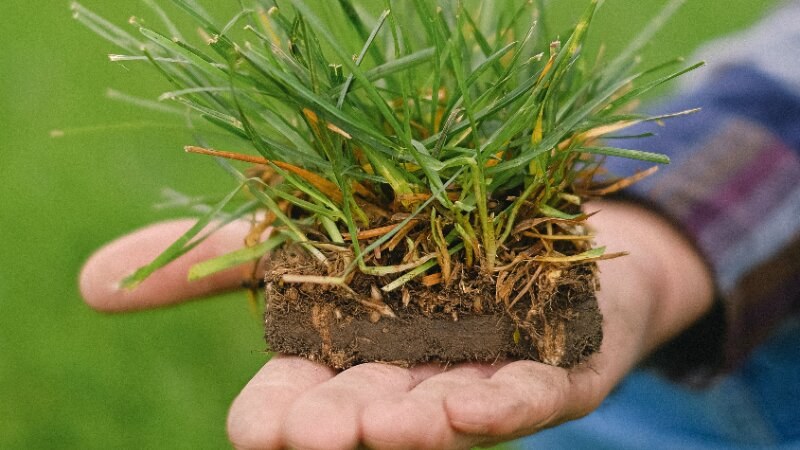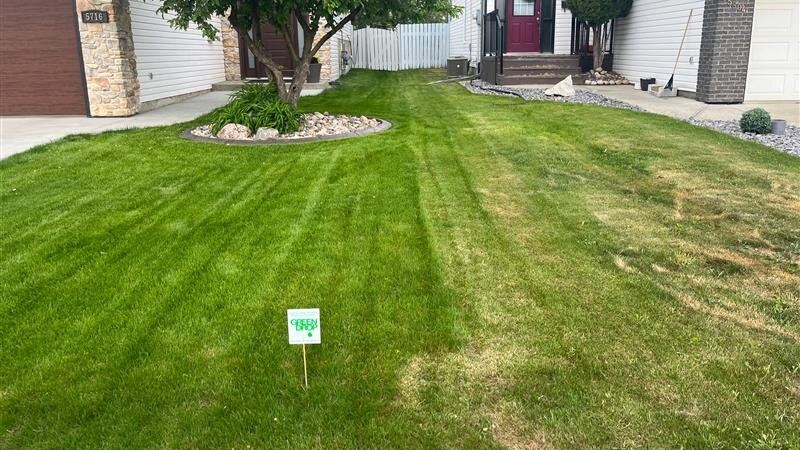5 Signs Your Lawn Needs Overseeding and What to Do About It
Reading time: 6 minutesOverseeding simply means adding grass seed without changing your lawn or the soil underneath. It’s a great way to “spruce up” your lawn without damaging your turf.
It’s a common misconception that grass only needs to be overseeded when there’s a problem. While lawn overseeding can help with many issues, it’s also a good habit to practice regularly. But if you’re not seeding at least once annually, it’s important to be aware of signs that your lawn needs some extra care.
Here are 5 indicators your grass needs overseeding, the benefits you can expect, and where to go for more information about how to take care of your lawn.

1. Your Lawn Looks Tired and Worn Out
Grass can die for various reasons, like poor soil conditions, waterlogging, drought, poor oxygen circulation, and even too much thatch buildup. If you notice that your grass looks like it has seen better days, overseeding can help bring back its lush, full appearance.
Just be sure to address whatever soil conditions or other problems caused the dieback in the first place – if not, your new grass will likely just suffer the same fate in time.
2. You Have a Lot of Thatch
Thatch is a layer of dead leaves, roots, and grass clippings that can get matted down where the blades of grass and soil meet. When too much thatch has accumulated, the soil and grass roots underneath have a harder time accessing the nutrients and water needed for sustainable growth.
Dethatching is potentially necessary at this stage, but it will likely leave your lawn looking bare or thin since the grass essentially took a hiatus from growing. Once your lawn is dethatched, aerate and overseed to loosen hardened soil and bring back thick, healthy grass.
3. Your Grass Isn’t Growing
If your grass isn’t growing or growing too slowly, this could indicate that your lawn needs some TLC – even if it’s still thick and green. Slow growth is usually the first sign of a problem before you start seeing brown patches or dead grass.
Slow growth means that your grass has depleted all of the nutrients in the soil and essentially has nothing to “eat.” Applying fertilizer may seem like the best fix, but fertilizing hard, compacted soil can waste time and money.
A better strategy would be to aerate your lawn, overseed it, and then fertilize it. Aerating your lawn before seeding and fertilizing creates more space for the seeds and nutrients to make complete contact with the soil underneath the grass. Waiting to fertilize also protects new grass from exposure to harsh chemicals that could damage it.
4. Discoloured Grass
Speaking of brown patches, if your grass starts turning yellow or becomes discoloured, this is another sign that lawn aeration and overseeding should be on the horizon.
The most common cause of grass discolouration is soil compaction. When grass is walked and rained on repeatedly, soil particles are pushed down towards the roots. The more compacted a section of soil becomes, the more difficult it will be for the grass to get enough nutrients, moisture, and oxygen.
Aerating your lawn can help loosen hardened soil and open channels for water and fertilizer to flow through. However, you’ll also need to overseed to help cover up yellow or brown patches with fresh green grass.
5. It’s Been a Few Years Since You Last Overseeded
The grass is meant to grow in a cycle that replenishes itself. Wild grass will flower, spread its seeds back into the soil, and grow again. When cultivating your lawn, you need to replicate this process. Since you’re mowing the grass before it has a chance to flower, it won’t bear seeds that grow into new blades on its own. Adding seeds periodically ensures the cycle continues and your lawn stays vibrant and green.
Overseeding can usually be done seasonally, either in the spring or fall, when it’s not too cold or hot outside for baby grass blades to thrive. But if you haven’t seeded in a few years, you can be confident your lawn will love you for it.
Top Benefits of Overseeding Your Lawn
There are dozens of benefits to be had when you overseed your lawn (especially when you combine it with aeration first), like:
- Opening up compacted soil so seeds can get in where they will be able to root.
- Allowing more oxygen, nutrients, and water to reach your lawn’s root system.
- Creating strong roots that hold up well to temperature and moisture fluctuations.
- Preventing lawn weeds and grass diseases from taking over as easily.
- Reducing the amount of pesticides needed to keep insects from causing visible damage.
- Revitalizing your lawn before it's due for seasonal weather stress.
- Reducing the chances of soil erosion and water runoff, so moisture and nutrients are retained.
- Increasing the durability of your grass before the summer or winter when foot traffic and snow on your lawn pose a threat.
- Reducing the need for fertilizers since overseeding can produce thick, lush grass without additional lawn treatments.
- Introducing new varieties of grass that are more resistant to heat, drought, insects, frost, etc., so if one type of grass is affected, another kind won’t be.

Proper Lawn Care After Overseeding
After overseeding your lawn, how well you care for it determines how effective the practice is. If you neglect your grass during this crucial time, all your work could ultimately amount to nothing if the seeds don’t root.
Successful overseeding depends on these key components:
- Your lawn needs to get enough water after planting the seeds, but too much water can wash seeds that haven’t been rooted away.
- For the first 2 weeks after seeding, water about 1 inch into the soil to prevent oversaturation.
- Once the seeds have germinated and you begin to see new blade growth, you can switch to less frequent but longer watering sessions to encourage your lawn to develop a deep root system.
- When the grass is fully established, you can water it as recommended by your lawn care expert, depending on the type of grass you have and your local climate.
While overseeding your lawn helps it look better long-term, your grass may look a little unkempt for the first few weeks. Patience is key, and in time, you will have a healthier, lusher-looking lawn that uses water and lawn fertilizer more effectively.
Learn More About Best Lawn Care Practices
Aeration and overseeding are excellent for preparing your lawn for spring, but you can also do them in the fall before winter if your grass looks rough after a hot and dry summer. When done properly, overseeding can completely transform your lawn in a season.
To learn about comprehensive lawn care, visit our knowledge base, where you can read tips and tricks for great-looking grass, things to avoid, and more.
Our team of experienced lawn experts—we call them GreenKeepers—are here to help in Calgary, Edmonton, Red Deer, Regina, Saskatoon, and Winnipeg.

